With the world around us going MANDALORIAN-crazy, it seemed like the perfect time to re-present this offering, originally published May 18, 2005, just as REVENGE OF THE SITH, the most recent Star Wars film, was about to hit theatres. Enjoy:
It’s time once more for one of our trips in the Wayback Machine. This time? We’re headed to the summer of 1977, as L’il Scott, like every other kid on the planet at the time, had the formative cinematic experience of his young life upon seeing STAR WARS for the first time. Here’s a reality check for those of you younger readers who might be a little spoiled by your current media-heavy lifestyle. Not only was there no Internet on which to watch clips and trailers, there was no DVD released in a few short months, no home video, and not even any cable TV to watch it on later that year. Nothin’.
So how was L’il Scott supposed to get his Star Wars fix back in the prehistoric seventies? How else? Comics. Yes, in one of the cannier publishing decisions of the era, Marvel hit the ground running with an ongoing STAR WARS comic book in May of 1977, adapting the movie for the first six issues, then telling all-new stories after that.
Let’s take a look at a Marvel-produced vision of STAR WARS, exactly how Marvel adapted the movie, and where they went from there.
As the story goes, when George Lucas was making arrangements with Fox for merchandising his soon-to-be-released science-fiction feature, he came to them with certain specific requests for the kinds of merchandise he wanted to see. Novelization? Check. Soundtrack album? Check. Action figures? Check. (In an amusing sidenote, reportedly when Lucas saw the array of toys and games Kenner had developed for STAR WARS, he looked it over and said “Where are the guns?” The Kenner rep nervously explained that toy guns simply weren’t done any more, that parents wouldn’t buy them in the post-Vietnam atmosphere. Lucas took a beat, then asked again “Where are the guns?” Lucas got his guns, and they sold like hotcakes.
L’il Scott had one, his trusty “Han Solo Laser Pistol.” I always wanted the “Stormtrooper Blaster Rifle,” too…) Last on his must-have list was a comic book, and Fox licensing types ran off to Marvel in the hopes of making a comics deal. It’s said that Marvel publisher Stan Lee wasn’t all that interested in putting out a STAR WARS comic, but the company’s then-Editor-in-Chief Roy Thomas, a longtime fan of Saturday-morning adventure serials and old sci-fi comic strips like Flash Gordon and Buck Rogers, liked what he saw of the movie, and went ahead and made the deal.
Sci-fi buff that he was, Thomas wrote the new series himself, with illustrator Howard Chaykin providing the art. Thomas and Chaykin hadn’t seen the movie yet when they did the work, which accounts for some of the more curious coloring choices in the book’s early issues (for example, the green Darth Vader that appears on the cover of the book’s first issue), as well as a few of the scenes that don’t even appear in the movie. In fact, I think the comic book accounts for one of the most frequently heard rumors about STAR WARS, one that I heard all through high school and college: I don’t know how many people I’ve talked to over the years who are convinced they saw the long-lost missing scene between Luke Skywalker and his childhood friend Biggs on Tatooine at the beginning of the film, and that it was cut from later theatrical releases and home video. A mass hallucination? A Lucasfilm-induced conspiracy? Hardly. It’s my contention that what so many adult STAR WARS fans are misremembering from their childhood is actually this sequence from STAR WARS #1 (July 1977), in which Luke’s friend Biggs Darklighter returns from the Academy to inform Luke of his intentions to jump ship at the earliest opportunity and join the Rebel Alliance.
The fact that so many people remembered this scene even though it wasn’t in the movie can be chalked up to the astounding success Marvel enjoyed from the STAR WARS comics, with the first three or four issues seeing multiple print runs, a very unusual circumstance in the comics market of the 1970s. Marvel even had to go to the then-unusual step of marking the comics, usually on the front cover or the opening splash page, so as to protect fans attempting to buy the originals on the at–that-time still-new collector’s market.
Speaking of which, the sharp-eyed among you may have noticed that Marvel’s masthead is absent from the above cover from issue #1, as it will be on any other covers herein reproduced. What’s the scoop? Well, as it turns out, George Lucas’s as-always top-notch attorneys insured that, while Marvel produced the STAR WARS comics, they would remain the property of Lucasfilm. Accordingly, when Dark Horse Comics acquired the Star Wars license for comics in the 1990s, they found themselves in the position of being able to reprint the original 107-issue Marvel run as well, which they’ve done, in 7 well-put-together paperback collections, with what looks to be Marvel’s full cooperation, with the excision of the Marvel masthead on the covers the only apparent change. In fact, Dark Horse has done a truly noteworthy job preserving these books, even retaining all of the quirky miscolorings of the originals, resisting the temptation to go back and fix the mistakes of the past, something that can’t quite be said of Lucasfilm’s own exalted emperor. It’s nice to have these comics on the shelf, not only because they’re a lot of fun, but also because my own STAR WARS comics were read so often and handled so much as a kid that they’re practically in liquid form today held together mostly by a mylar bag and the sheer will power on my part.
Another fun moment from the comics that didn’t make it into the movie (at least, not for 20 years or so) is Han Solo’s encounter with Jabba the Hutt on Tatooine, just after shooting Greedo in the cantina (and shooting first, I might add). Upon his return to the Falcon, Solo is met by the awaiting Jabba, who resembles neither the sluglike fellow we would become familiar with from RETURN OF THE JEDI, nor the heavyset gent with the Irish accent who was actually filmed on set with Harrison Ford. Instead, the Marvel Comics Jabba is a pale yellowish walrus dude, who looks like he buys his clothes at “Bucky Barnes for Men.”
Howard Chaykin’s art in the first issue is much more harder-edged and scratchy, with Chaykin providing both pencils and inks. He does a good job of suggesting the likenesses of the actors without being slavish to them, especially considering he’s working only from stills and maybe a few clips, since neither he nor writer Thomas had seen the film when they were producing the comics. As of the second issue, Chaykin was joined by inker Steve Leialoha, who softened up the art considerably, tightening up some of the likenesses and generally providing a tighter, smoother line to the entire endeavor. The difference is made all the more apparent in the third issue, in which the Chaykin/Leialoha art is followed by a Howard Chaykin solo pinup, which is noticeably rougher and more “cartoony” than the story that preceded it.
As much as I love Steve Leialoha’s work, there’s something to be said for Chaykin’s rough approach as well – his puckish portrayal of a spunky Leia Organa is particularly appealing (although admittedly more buxom than she ever appeared in the movie).
The covers were also good, if occasionally a little bewildering. The first three are pretty straightforward, while the fourth veers into slightly more symbolic territory, with an ominous Darth Vader looming over the figures of Luke, Leia and Ben Kenobi.
This pales next to the unabashed false advertising of the cover to issue #6, which not only promised a lightsaber duel between Luke Skywalker and Darth Vader, but bewilderingly featured Darth Vader wearing what looks for all the world like a television screen over his genitals.
It’s also clear that Chaykin hadn’t quite gotten the chance to absorb any of the soon-to-be-famous special effects shots, as evidenced by these unusually snub-nosed X-Wing fighters:
Similarly, Obi-Wan’s sacrifice on the Death Star looks a lot grislier here than I remembered seeing in the theatre:
As for the writing, Roy Thomas is, well, Roy Thomas. No one’s better at pacing and storytelling, but he also loves the narrator’s voice. I’m as big a Rascally Roy fan as you’ll find, but he’ll never use five words if 15 will do. Just take a look at this page from the climactic explosion of the Death Star, a moment that should probably be able to stand on its own, if anything can. Take it away, Roy:
Like Chaykin, you can tell Thomas hadn’t been able to see the movie, as some familiar moments seem to take on a different tone. For example, take the rather blasé scene from early in the film when Uncle Owen asks where Luke and the droids have gotten off to:
Owen’s a lot more fired up about those vapor condensers here, isn’t he?
Roy’s influence on the series isn’t really seen until STAR WARS #7 (January 1978), when Thomas had the daunting task of telling new stories, taking place after the movie’s end. Wisely, Thomas decided to focus the series, at least initially, on Han Solo and Chewbacca, probably figuring that they’d give him the best opportunity for “high adventure” in space.
In a clever device, Thomas had Solo immediately robbed of the reward he’d gotten from the Rebels to pay off Jabba’s debt, forcing the smuggler to lay low and go underground again, dodging bounty hunters and looking for a way to make some quick cash.
On the run, Solo and Chewbacca find themselves on a backwater planet called Aduba-3, where they accept a job fighting off outlaws for a group of poor farmers. As always, Thomas was unable to resist a “homage” to another famous work, and gives the reader a riff on THE MAGNIFICENT SEVEN (or THE SEVEN SAMURAI, depending on your frame of reference), with Solo recruiting some extra muscle, in “Eight for Aduba-3”:
So who do Han and Chewie sign up? First to join is Hedji, a caped porcupine dude known as a “spiner,” who eschews a blaster in favor of the quills he can fire from his body at will. Next up is Amaiza, former “den-mother” for the Black-Hole Gang, who apparently has a history with Solo. Also looking to join is (I hesitate to even type it) Don-Wan Kihotay, a demented old coot with delusions of having been a Jedi Knight. Next up is Jimm, a Luke Skywalker-type who’s taken to calling himself the “Starkiller Kid.” Yeesh. Jimm is accompanied by a somewhat uppity treadmill droid called FE-9Q, or “Effie” for short.
Solo’s final recruit is – get this – a seven-foot-tall green carnivore rabbit. Named Jaxxon. Or “Jax for short. Which I ain’t.”
Jax the Rabbit. Ay caramba.
As it turns out, this story would be Roy Thomas’ last storyline on STAR WARS, as he reportedly began to dislike the increasing pressure from Lucasfilm for creative control of the series. (The rumor is that George Lucas was none too happy with the seven-foot-tall green rabbit…) With Thomas gone, the series fell into the capable hands of writer Archie Goodwin, who had a much better sensibility for the series. Also joining the series with issue #11 was comics great Carmine Infantino, who may have been a little less arduous on the likenesses, but more than made up for it with the style and dynamic storytelling to the book. Picking up where Thomas left off, Goodwin refocused the series on Luke, who had been considered lost by the Rebels while off searching for a new planet for the Rebel base. Luke and the droids find themselves on a waterworld (a couple of decades before Kevin Costner thought of it, mind you), where technology and the ability to repair it is both shunned and jealously protected. While Luke contends with a Captain Bligh-like warlord and duels with water-breathing dragons (it looks like he’s posing for ‘80s Asia albums)…
…Han and Chewie have another encounter with Crimson Jack, the pirate who stole all his treasure back in issue #7, and his man-hating lesbian first mate Jolli, who suddenly finds herself eyeing the manly Captain Solo. Jack has captured Princess Leia, who was off looking for Luke, and soon Leia and Han are manipulating the pirate into continuing the search of for Luke, while Leia and Jolli settle in for a little girl talk.
The group is reunited when they manage to set the warlord, the dragons and Crimson Jack against each other, and after a final zero-g showdown between Solo and Crimson Jack, they’re on their way once more.
The story closes out with a tender if a little creepy moment between Solo and the recently deceased Jolli, who had been killed taking down her former boss’s ship after Jack left her to die in space.
This is only the tip of the iceberg when it comes to Marvel’s Star Wars comics, folks. While the quality of the series varied greatly, especially after Lucasfilm began setting more and more dictates on the storytelling, the series was consistently fun space opera with some pleasantly familiar characters, and back in the day, you couldn’t ask for much more than that for a measly thirty-five cents. If you’re still in a STAR WARS mood after REVENGE OF THE SITH, why not check out some of these smart-looking TPBs, and find out what we old-timers had to do to get our Star Wars fix.

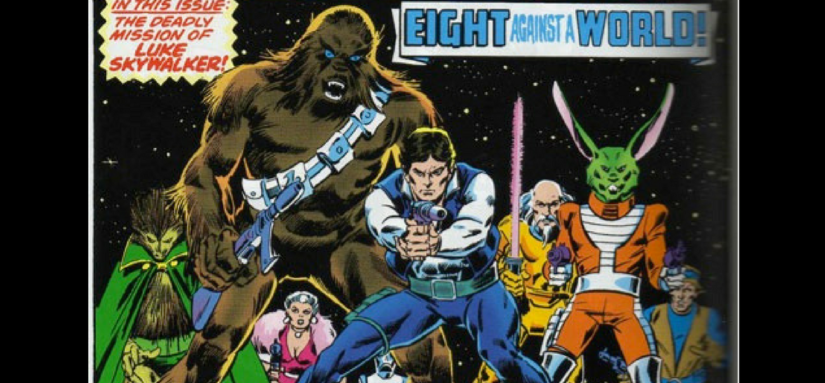


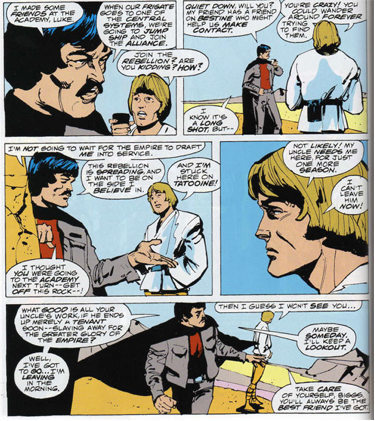
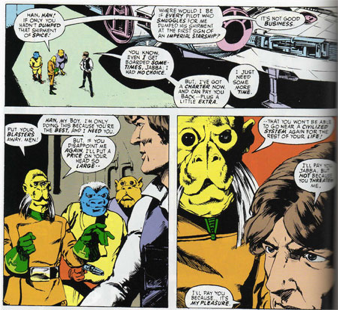
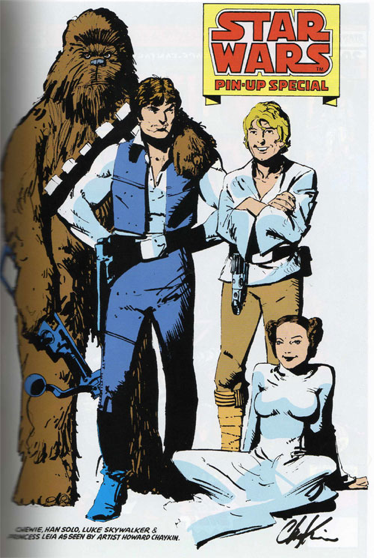
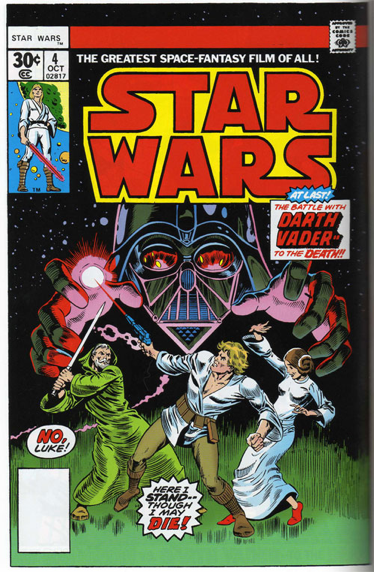
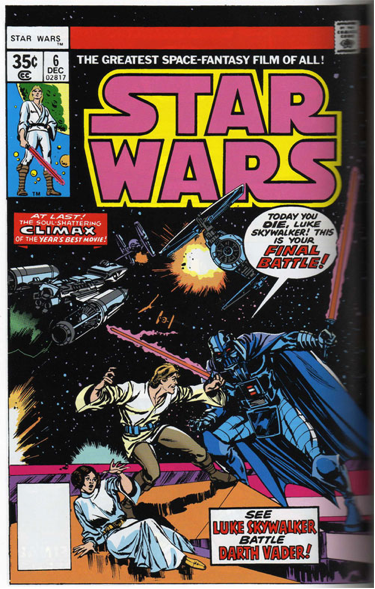












Comments are closed.